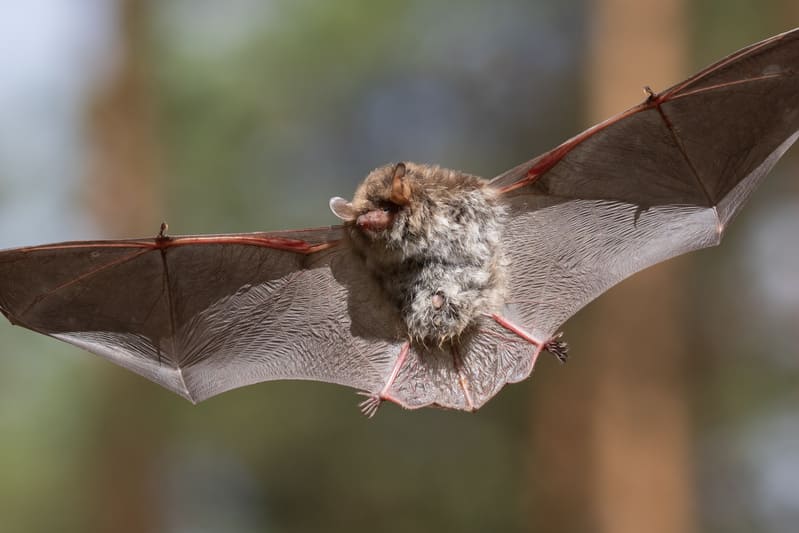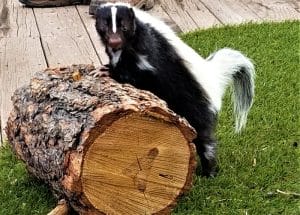You’re watching a TikTok video or making dinner when you hear wings flapping overhead. Frowning, you wonder if your significant other or one of the kids left the front door open, letting a bird inside. You look up, only to see a bat -not a bird- flying in circles close to the ceiling.
We get it- few things are more annoying than uninvited guests. But there’s something about bats that a lot of people find spooky. If you’re one of them, you may be tempted to scare it off or worse. Before you do it, call Bad Company Wildlife Eviction for humane bat removal in Ontario. If you live in the Hamont area, and search for ‘bat removal near me,’ you’ll likely find us!
Why Are There Bats in My Home?
There’s a reason why bats are active right now. Early in the summer, female bats gather in colonies, where they will remain until their pups are ready to fly. Some bat species have adapted to live in human structures, such as attics, barns, and roofs. Bat pups, or baby bats, are now independent and are venturing outside their roosts at this time of year. Currently, they are mastering the art of flying and learning how to hunt insects. You may get a surprise visit from a young bat who hasn’t yet learned how to echolocate.
It should be noted that the Fish and Wildlife Conservation Act prohibits killing bats, even if they have intruded into your home or attic. A number of species of bats in Ontario are listed as Specially Protected Mammals, which cannot be hunted, trapped, or killed. They include:
- Big Brown Bat (Eptesicus fuscus)
- Eastern Pipistrelle Bat (Perimyotis subflavus)
- Hoary Bat (Lasiurus cinereus)
- Least Bat (Myotis leibii)
- Little Brown Bat (Myotis lucifugus)– This is the one you’re most likely to find in your attic
- Northern Long-Eared Bat (Myotis septentrionalis)
- Red Bat (Lasiurus borealis)
- Silver-Haired Bat (Lasionycteris noctivagans)
If you need bat removal in Ontario, there are humane options available. Learn what they are by contacting Bad Company Wildlife Eviction.
Things You May Not Have Known About Bats
Sure, they’re a little intimidating when they’re circling your head, but once you get past that, you might be surprising to learn the following cool facts about them:
- They are the world’s only flying mammal!
- They can eat up to 1,200 mosquitos an hour. How’s that for all-nature pest control?
- There are bat species that live for more than 30 years and can fly at speeds of up to 60 miles per hour.
- Bats can find their food in total darkness using echolocation (meaning that they use audible high-pitched sounds and listen to echoes).
- Guano, or bat droppings, is one of the richest fertilizers on earth.
- The flying fox is the world’s largest bat. It lives on islands in the South Pacific.
How Do Bats Get in Your Home?
If there are open windows or doors in your house, a curious or lost bat might fly in. It’s probably looking for an escape route if that is the case. If you’re dealing with a single bat, you may be able to gently get it outside by taking the following steps:
- Keep pets and children away and remain calm.
- Keep near the wall as the bat tends to fly in a U-shaped pattern, flying higher near the walls and lower in the center.
- Ensure that interior doors are closed and that the bat has a way out through a door or window. Wait until the bat lands to try catching it if it doesn’t exit on its own.
Never handle a bat with your bare hands. It’s best to wear thick work gloves, but not cotton ones, since they’re easily pierced by teeth. If gloves aren’t available, you can capture a bat by rolling up a T-shirt or something similar. Make sure the material used is thick enough to prevent bites.
Bats usually land behind curtains or upholstered furniture, on hanging clothes, or in house plants where they can hang. Cover them with a plastic container or small box. Put a sheet of cardboard or another thin yet sturdy surface under the container to trap the bat. You can now release the bat outdoors. Most bats cannot fly from the ground, so tilt the container or allow the bat to climb a tree trunk.
If you’ve noticed multiple bats, a colony may have taken up residence in your attic. In the fall or spring, bats invade your living space to have babies. In any season, bats can enter through entry points less than 3/8″ wide. There may be gaps in your siding, roof, or soffit, as well as chimneys and attic vents. If they feel comfortable, they’ll stay as long as they want to, which can be indefinitely.
A bat should not be removed from a home during inclement weather, mid-winter, or maternity season, which lasts from mid-June to early August. When female bats are removed during these times, their babies may get trapped in the attic, where they will most likely die of starvation as they can’t fly. Don’t take a chance: if you need bat removal in Ontario, call us instead.
Signs Of A Bat Infestation In Your Home
Even though bats are great for the ecosystem, they pose a health risk if they live in your attic. Here are some things to look for.
Flapping and Scratching Noises
Often, homeowners assume strange sounds coming from their attics are coming from mice or rats. However, when they listen closer, they hear bats flapping their wings and scratching. When the bats come and go at dusk and dawn, this is particularly common. They have rush hour just like you and I do. However, their shift is nocturnal, and your house is the highway!
High-Pitched Squeaking
When bats are outside, they communicate at a high frequency most humans cannot hear. At night, however, one can hear noises from multiple bats coming from the attic. The noise is quite faint, but if you have dozens of them in your attic, it could grow increasingly noticeable.
Grease Marks
Bats have dirty, greasy coats. It’s a safe bet to assume bats live in your attic if you see a dark-brown or charcoal-gray residue on a hole. Their entry point is usually small, so they have to squeeze through it. The oil comes off during the process, and the buildup becomes apparent after repeated entries and exits.
Droppings
Unlike birds’ guano, bat guano looks like a small, elongated pellet. Due to its phosphorous and nitrogen content, it is actually used as fertilizer, but you don’t want it inside your house. Piles of it can be found in the attic or in the insulation under bat roosts. With time, guano turns into a fine dust, so you’ll probably want to leave guano cleanup to professionals.
How Does Bat Removal in Ontario Work?
When you call Bad Company Wildlife Eviction, we do a thorough inspection of your property, keeping an eye out for common entry points.
After identifying all entry points, we install one-way bat exits at each. Using these setups, the bats can exit your home but not re-enter. We install preventative screening and caulking to secure weak points and prevent bat re-entry. We return later to permanently seal the openings and remove the one-way bat exits. No animals are harmed, and your home is all yours once again!
Need to Get Bats Out of Your Attic? Call Us!
There is a place for bats in our ecosystem, but we don’t want them in our attics! Contact Bad Company Wildlife Eviction if you notice signs of infestation and think, “How do I find bat removal near me?” After humanely removing the bats from the attic, we seal it to prevent future infestations and carry out follow-up inspections when needed. To learn more or schedule an estimate, call 1-855-880-9860.



